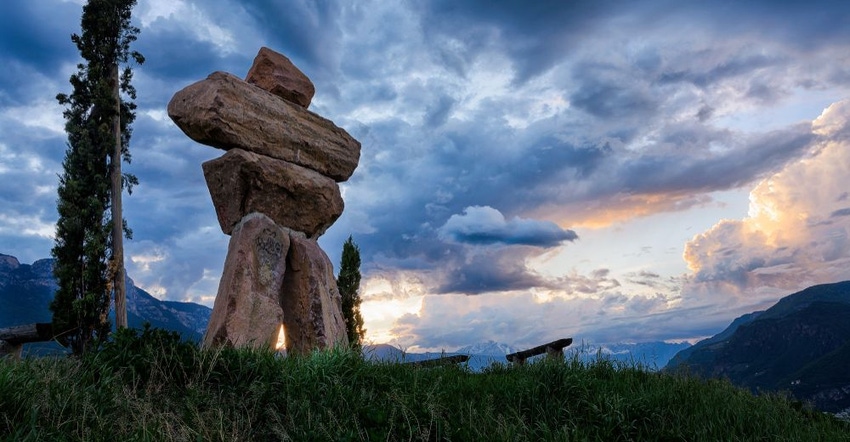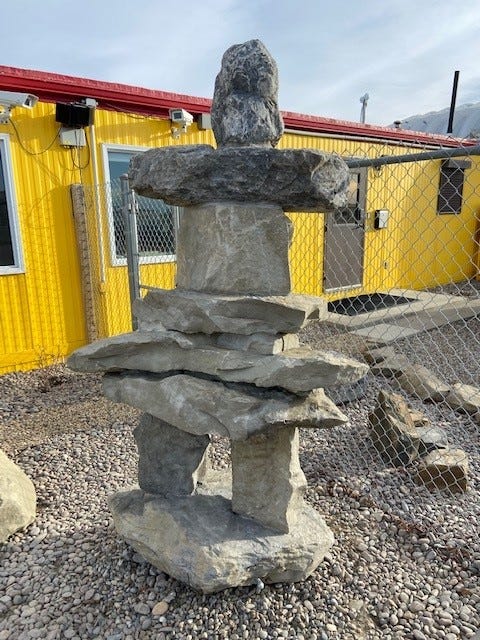People living in the harsh regions of the Artic have historically used stacked-stone inukshuks as landmarks. When shaped in human form, these figures signify safety, hope and friendship. A Canadian self-storage operator explains how he created his own inukshuk to welcome tenants to his property.

The first time I saw an Inuit cairn made from stacked rocks, called an inukshuk, I was working in the gas and oil industry in Canada. The bulk of my time was spent in Alberta, with shorter terms up north. It was in some of the towns and villages in the Yukon and Northwest Territories that I came across my first soap carvings, pictures, and hand-crafted stone and glass inuksuit (inukshuks). These small replicas were typically made by local craftsmen as table ornaments or home decorations.
The far north is a rugged, stark environment. In that harsh setting, stone cairns were an ideal way for the Inuit to create landmarks. They’re used to indicate direction, hunting areas, food stashes or sacred grounds. An inukshuk built in the shape of a human signifies safety, hope and friendship. Historically, this was the form favored by craftsmen, as it was easily recognizable for everyone. Though I didn’t know it then, the inukshuk would one day become part of my family’s life, too.
A New Path
As I neared the end of my career in the petroleum industry, I decided to make a long-term investment in real estate for my family. A 40-acre parcel of land became available, and I purchased it. It seemed ideal, as it was near Calgary, and close to major highways and developing properties in the immediate area.
The land use was quite restricted at that time. Vehicle storage was one of the few developments allowed, so I decided to proceed down that path. Facility planning and initial construction began in 2008. Shorty’s Storage opened two years later, offering 700 vehicle spaces and 60 sea containers.
An Idea Forms
An expansion in 2018 required significant excavation work to control surface-water runoff, and we encountered some sandstone at shallow depths. We ended up with a significant number of large pieces and decided to incorporate some into the landscaping around the management office. It was in the process of placing these big rocks that I recalled the stacked cairns I’d seen in the north country and suggested we build our own inukshuk. A family member recommended putting it near the main entrance.
The idea was easy compared to the task of actual construction. The rocks we had didn’t fit well together, but we were afraid to prop them up with little shim rocks the way the Inuit did, as we didn’t want to chance it falling over. So, we faced the challenge of sculpting the rocks into the required shapes.
The weather got cold, so we decided to move the project into the warmth of our workshop. I worked with my grandson, Kaelan, and my nephew, Todd, to gather the rocks with a front-end loader and slings. However, there were so many of them, and they were so large—some were well in excess of 200 pounds—that we couldn’t fit them all inside. In the end, we left them in an accessible area and just brought them in as we fit each one from the bottom up.
We shaped the rocks with a combination of hand tools including a skill saw with a concrete blade, an angle grinder with a masonry cut-off blade, and rock chisels with regular hammers. We had to break several of the large rocks prior to shaping them and even purchased a small set of rock splitters to accomplish this task.
After we had placed a few stones, it became evident that the rocks weren’t stable despite being sculptured to fit. We stabilized the joints by drilling deep holes that lined up between each pair of rocks and then ran rebar, which was epoxied into these holes.
The moving and placing process required lots of planning, as the finished inukshuk weighed more than 1,600 pounds! It had to be secured firmly to the loader bucket to prevent it from tipping. We proudly added the figure near the front entrance of our storage facility about two months after our project began.
The inukshuk is a unique feature for our self-storage site. I don’t think many of our clients know it means safety, hope and friendship, but we’re spreading the word, and I’m sure they’ll appreciate our gesture each time they enter our facility. I believe it’ll become a recognizable and integral part of Shorty’s. We’ve had nothing but great comments and feedback from our tenants.
We’re still coming up with a name for our inukshuk. It’s definitely too tall to be called “Shorty” at 7 feet high! I considered building a mini-me version to put beside the big one, then we could call him by that name; but right now it’s still just an idea.
Dennis Gieck is owner of Shorty’s Storage in Calgary, Alberta. The family-operated facility offers 1,100 vehicle-storage spaces and 60 sea containers for rental. To reach him, call 403.266.2206 or email [email protected].
About the Author(s)
You May Also Like





